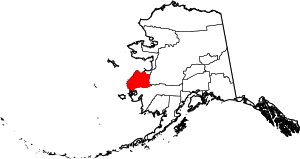Nunam Iqua, Alaska
| Nunam Iqua | |
|---|---|
| City | |
 Nunam Iqua Location within the state of Alaska | |
| Coordinates: 62°30′58″N 164°53′43″W / 62.51611°N 164.89528°WCoordinates: 62°30′58″N 164°53′43″W / 62.51611°N 164.89528°W | |
| Country | United States |
| State | Alaska |
| Census Area | Kusilvak Census Area |
| Incorporated | 1974[1] |
| Government | |
| • Mayor | Edward Abrahamson, Jr.[2] |
| • State senator | Donald Olson (D) |
| • State rep. | Neal Foster (D) |
| Area | |
| • Total | 18.5 sq mi (48 km2) |
| • Land | 13.2 sq mi (34 km2) |
| • Water | 13.2 sq mi (34 km2) |
| Population (2010) | |
| • Total | 187 |
| • Density | 10/sq mi (3.9/km2) |
| ZIP code | 99666 |
| Area code | 907 |
Nunam Iqua, formerly called Sheldon Point, is a city in the Kusilvak Census Area in the U.S. state of Alaska. At the 2010 census the population was 187.
Nunam Iqua is a Yupik name meaning "the end of the tundra". A man named Sheldon opened a fish saltery there in the 1930s, and the city was incorporated under the name Sheldon Point in 1974. The name was changed to Nunam Iqua in a November 1999 referendum.[3]
Geography
Nunam Iqua is located at 62°30′58″N 164°53′43″W / 62.51611°N 164.89528°W (62.516094, -164.895198).[4]
According to the United States Census Bureau, the city has a total area of 18.5 square miles (48 km2), of which, 13.2 square miles (34 km2) of it is land and 5.3 square miles (14 km2) of it (28.80%) is water.
Demographics
| Historical population | |||
|---|---|---|---|
| Census | Pop. | %± | |
| 1950 | 43 | — | |
| 1960 | 125 | 190.7% | |
| 1970 | 125 | 0.0% | |
| 1980 | 103 | −17.6% | |
| 1990 | 109 | 5.8% | |
| 2000 | 164 | 50.5% | |
| 2010 | 187 | 14.0% | |
| Est. 2015 | 203 | [5] | 8.6% |
As of the census[7] of 2000, there were 164 people, 35 households, and 26 families residing in the city. The population density was 12.4 people per square mile (4.8/km²). There were 45 housing units at an average density of 3.4 per square mile (1.3/km²). The racial makeup of the city was 5.49% White, 0.61% Black or African American, 90.24% Native American, and 3.66% from two or more races.
There were 35 households out of which 57.1% had children under the age of 18 living with them, 31.4% were married couples living together, 28.6% had a female householder with no husband present, and 22.9% were non-families. 17.1% of all households were made up of individuals and none had someone living alone who was 65 years of age or older. The average household size was 4.69 and the average family size was 5.22.
In the city the population was spread out with 51.8% under the age of 18, 8.5% from 18 to 24, 23.8% from 25 to 44, 11.6% from 45 to 64, and 4.3% who were 65 years of age or older. The median age was 17 years. For every 100 females there were 124.7 males. For every 100 females age 18 and over, there were 97.5 males.
The median income for a household in the city was $29,000, and the median income for a family was $26,250. Males had a median income of $48,750 versus $24,375 for females. The per capita income for the city was $6,725. About 40.6% of families and 36.3% of the population were below the poverty line, including 40.9% of those under the age of eighteen and none of those sixty five or over.
References
- ↑ 1996 Alaska Municipal Officials Directory. Juneau: Alaska Municipal League/Alaska Department of Community and Regional Affairs. January 1996. p. 141.
- ↑ 2015 Alaska Municipal Officials Directory. Juneau: Alaska Municipal League. 2015. p. 118.
- ↑ Alaska Community Database: Nunam Iqua. Retrieved 30-Aug-2007.
- ↑ "US Gazetteer files: 2010, 2000, and 1990". United States Census Bureau. 2011-02-12. Retrieved 2011-04-23.
- ↑ "Annual Estimates of the Resident Population for Incorporated Places: April 1, 2010 to July 1, 2015". Retrieved July 2, 2016.
- ↑ "Census of Population and Housing". Census.gov. Archived from the original on May 11, 2015. Retrieved June 4, 2015.
- ↑ "American FactFinder". United States Census Bureau. Archived from the original on 2013-09-11. Retrieved 2008-01-31.

